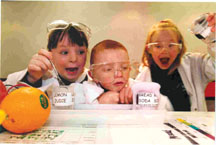
Acids and bases - what are they?
Every liquid you see will probably be either an acid or a base. The
only exception would be distilled water. Distilled water is just water.
That's it. Most water you drink has ions (electrically charged
particles) in it.
Those ions in the solution make something acidic or basic. In your
body, there are small compounds called amino acids. Those are acids. In
fruits, there is something called citric acid. That's an acid, too. But
what about baking soda? When you put that in water, it makes a base.
Vinegar is also an acid.

Scientists use something called the pH scale to measure how acidic or
basic a liquid is. The scale goes from values very close to 0 through
14. Distilled water is 7 (right in the middle). Acids are found between
a number very close to 0 and 7. Bases are from 7 to 14. Most of the
liquids you find everyday have a pH near 7. They are either a little
below or a little above that mark. When you start looking at the pH of
chemicals, the numbers go to the extremes.
If you ever go into a chemistry lab, you could find solutions with a
pH of 1, and others with a pH of 14. There are also very strong acids
with pH values below 1, such as battery acid. Bases with pH values near
14 include drain cleaner and sodium hydroxide (NaOH). Such chemicals are
very dangerous.
When learning about acids and bases, there are some definitions you
should know:
* Acid: A solution that has an excess of H+ ions. It comes from the
Latin word acidus that means "sharp".
* Base: A solution that has an excess of OH- ions. Another word for
base is alkali.
* Aqueous: A solution that is mainly water. Think about the word
aquarium. Aqua means water.
* Strong Acid: An acid that has a very low pH (0-4).
* Strong Base: A base that has a very high pH (10-14).
* Weak Acid: An acid that only partially ionises in an aqueous
solution. That means not every molecule breaks apart. They usually have
a pH close to 7 (3-6).
* Weak Base: A base that only partially ionises in an aqueous
solution. That means not every molecule breaks apart. They usually have
a pH close to 7 (8-10).
* Neutral: A solution that has a pH of 7. It is neither acidic nor
basic.
What really happens in those solutions? It gets a little tricky here.
We'll give you the straight answer. Acids are compounds that break into
hydrogen (H+) ions and another compound, when placed in an aqueous
solution. Bases are compounds that break up into hydroxide (OH) ions and
another compound, when placed in an aqueous solution.
Let's change the wording a bit. If you have an ionic compound and you
put it in water, it will break apart into two ions. If one of those ions
is H+, the solution is acidic. If one of the ions is OH-, the solution
is basic. There are other ions that make acidic and basic solutions, but
we won't be talking about them here.
That pH scale we talked about is actually a measure of the number of
H+ ions in a solution. If there are a lot of H+ ions, the pH is very
low. If there are a lot of OH- ions, that means the number of H+ ions is
very low, so the pH is high. |


